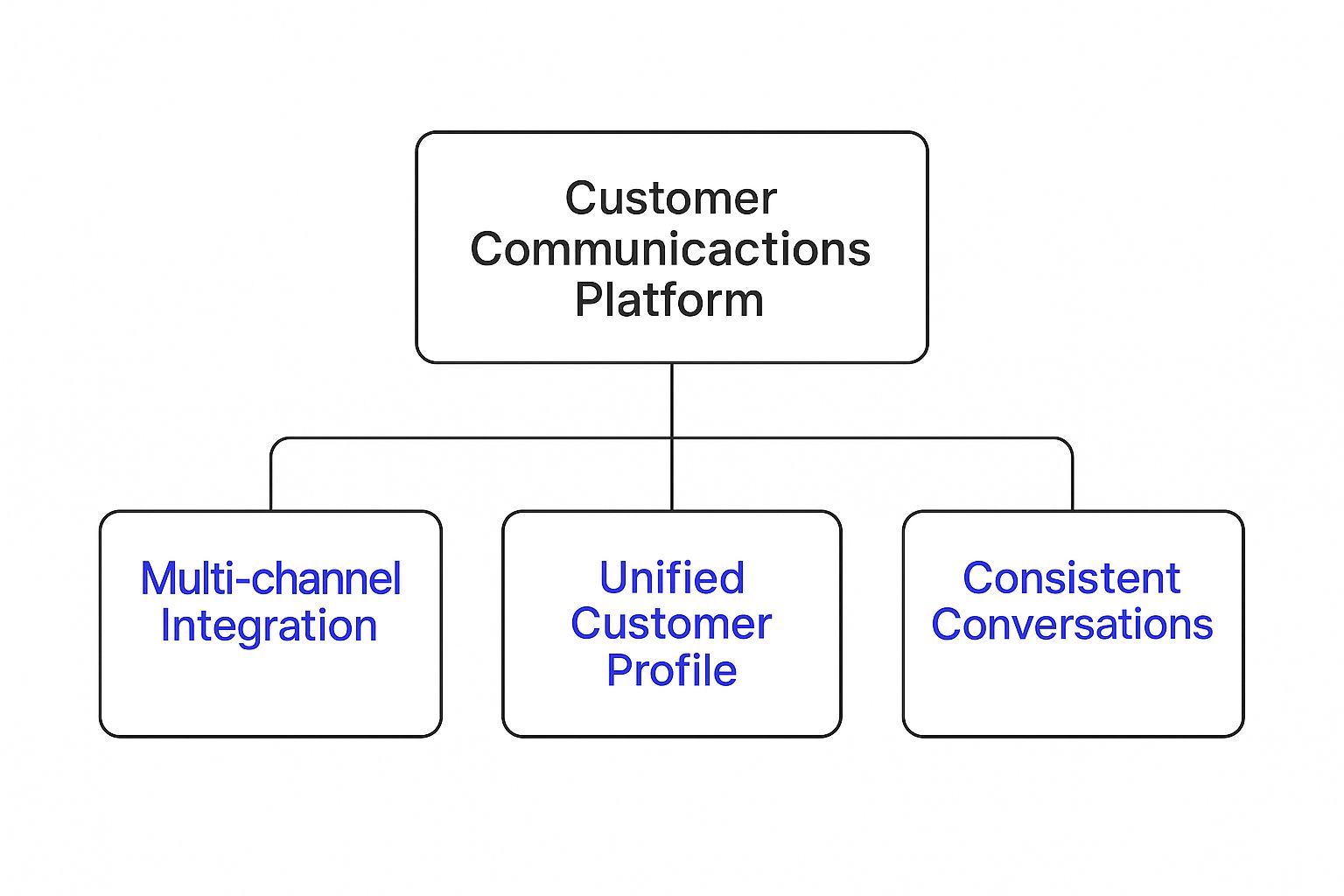A Guide to Customer Communications Platforms
Discover what a customer communications platform is, its essential features, and how to select the right one to unify your messaging and improve CX.

A customer communications platform is the central nervous system for all your customer interactions. It pulls together every channel, from email and chat to SMS and social media, into a single, unified system. The result? Your team gets a complete, 360-degree view of every customer's entire history.
What Is a Customer Communications Platform
Think about the last time you had to contact a business. Maybe you sent an email, then followed up with a live chat a few days later. If you had to explain your issue from scratch each time, you were probably dealing with a company using disconnected tools for each channel. It's a classic sign of a siloed setup, and it creates a clunky, frustrating experience.
A customer communications platform is designed to fix that fragmentation. It works like a universal inbox for your whole company, gathering every message from every channel and attaching it to a single customer profile. Instead of agents seeing isolated chats, they see the full story.
Why a Central Hub Matters
Juggling conversations across a dozen different apps is a recipe for chaos. Your support team might be buried in emails in one system while your sales team is handling social media messages in another. When everything is separate, no one ever has the complete picture.
A customer communications platform provides one source of truth. It allows your teams to see if a customer who just sent an email also chatted with support last week or commented on a social media post yesterday. This context is key to providing helpful and relevant service.
This unified approach means customers never have to repeat themselves. It also stops your internal teams from sending mixed or conflicting messages. The goal is simple: create one seamless conversation that can move from channel to channel without ever losing context. To really get the basics down, it helps to understand what modern answering services actually do as a foundational concept.
The Core Components of a Platform
A solid platform is built on a few core ideas that work together to organize and streamline every interaction.
- Multi-channel Integration: This is the magic that connects all your communication channels (email, SMS, social media, web chat) into one single dashboard.
- Unified Customer Profile: Every single interaction, no matter where it happens, gets tied to a single customer record. This builds a rich, detailed history of their entire journey with your business.
- Consistent Conversations: When your team has the full history at their fingertips, they can provide consistent and personalized responses, no matter which channel the customer chooses to use.
This diagram shows how a customer communications platform acts as the core, pulling in different channels to build out those unified profiles and create consistent conversations.

The visual makes it clear: the platform's main job is to bring order to chaos by merging separate communication streams into one coherent story. For any business looking to build stronger customer relationships, moving from siloed tools to an integrated system like this is a game-changer.
Core Features of a Modern Communications Platform

Not all communication tools are created equal. A true customer communications platform stands out because of a few core features that work together to turn scattered conversations into organized, meaningful relationships.
Think of it as the difference between a collection of individual tools and a fully integrated workshop. Let's break down what makes these platforms so effective.
Unifying Every Channel
The foundation of any great platform is omnichannel support. This means it brings all your customer touchpoints, such as email, live chat, SMS, and social media DMs, into one unified inbox. Instead of your team juggling five different apps, everything flows into a single, manageable queue.
This helps make sure no message ever falls through the cracks and gives your team a complete, real-time view of every conversation. For businesses aiming for a truly connected customer journey, understanding the benefits of an omnichannel customer experience is a must.
An omnichannel setup means a customer can start a chat on your website and follow up via email a day later, and your agent sees the entire history in one continuous thread. No more asking, "Can you remind me what we talked about?"
Creating a Single Customer View
Working hand-in-hand with the unified inbox is the unified customer profile. Every time a customer interacts with your business, the platform logs it. Support tickets, sales questions, purchases, it all gets attached to their profile.
This creates a living history of every conversation and transaction. When that customer reaches out again, your team instantly sees their entire journey, from past issues to buying habits.
For example, a support agent can see that a customer was browsing a specific product, asked about it on social media, and then bought it last week. That context is gold. It lets the agent provide help that’s actually helpful.
This single source of truth is what separates a basic tool from a powerful platform. It equips your team to have smarter, more personal conversations.
Automating the Repetitive Work
Modern platforms are also packed with powerful automation and workflow capabilities. These features are designed to take routine, mind-numbing tasks off your team's plate so they can focus on what humans do best: solving complex problems.
Think about all the manual work your team does daily, like assigning new messages to the right department or sending follow-up emails. A good platform can handle all of that automatically.
Here are a few common examples:
- Ticket Routing: Automatically send incoming messages to the right people based on keywords or the channel they came from. A message with "billing issue" goes straight to the finance team, no manual hand-off needed.
- Welcome Messages: Set up an automated SMS or email that goes out the moment a new customer signs up, giving them a warm welcome without any manual effort.
- Canned Responses: Create pre-written templates for frequently asked questions. This lets agents answer common queries with a single click, keeping responses fast and consistent.
These automations save time, dramatically speed up your response times, and reduce human error.
Measuring What Matters with Analytics
Finally, a robust platform has to include built-in analytics and reporting tools. You can't improve what you don't measure, and these features give you the hard data you need to see what's really going on.
These tools track key metrics that reveal how well your team is performing and where the friction points are. This data helps you spot bottlenecks, recognize your top performers, and make smart decisions to improve your entire communication strategy.
To tie it all together, here’s a quick look at how these core features solve real business problems.
Features of a Customer Communications Platform
When you see these capabilities working in tandem, it's clear that a customer communications platform is more than just an inbox. It is the command center for your entire customer experience.
How These Platforms Drive Business Growth

Thinking a customer communications platform is just about organizing your inbox is missing the bigger picture. It's really about changing how your teams work and how customers see your brand, which has a direct line to your bottom line.
When every conversation is connected, consistent, and has the right context, you start to see real, tangible improvements. These platforms become a growth engine, with positive effects rippling through your support, sales, and marketing teams. Let’s get into the specific ways this happens.
Better Customer Satisfaction and Loyalty
Slow replies and inconsistent answers are the fastest way to lose a customer. A customer communications platform hits these problems head-on by giving your team the right information, right when they need it. When an agent can see a customer's entire history in one place, they don't just solve problems, they solve them fast.
That speed and consistency make for happier customers. It’s no surprise that businesses using modern, cloud-based communication tools see a big jump in efficiency. When people feel heard and understood without having to repeat their story over and over, their trust in your brand goes way up.
For example, a retail company was bleeding customers due to high churn. They brought in a unified platform, giving their support team a complete view of every customer's orders and past complaints. The result? They cut resolution times by 40%, and churn dropped in less than six months.
This creates a powerful cycle. Better service leads to higher satisfaction scores, which builds the kind of loyalty that keeps customers coming back.
Increased Operational Efficiency
Fragmented systems are a recipe for friction and wasted time. Your team’s productivity takes a nosedive every time they have to switch between five different apps just to piece together a customer's story. A central platform gets rid of those roadblocks by consolidating tools and automating the boring stuff.
Think about all the manual work that goes into assigning tickets, sending follow-up messages, or digging up old conversations. A customer communications platform can automate those workflows, freeing up your team for more complex, high-value interactions. This makes your whole operation run smoother:
- Fewer Tools to Manage: Your IT team spends less time trying to maintain and integrate a patchwork of different software.
- Faster Onboarding: New hires get up to speed on a single system, not a dozen disconnected tools.
- Reduced Errors: Automation cuts down on human error, like a message getting lost or sent to the wrong department.
All this efficiency means your team can handle more conversations with less effort. It also trims the operational costs that come from specialized training and constantly fixing outdated, separate systems.
New Opportunities for Revenue
Great communication doesn’t just solve problems; it creates sales. When your sales and marketing teams have a rich, unified customer profile at their fingertips, they can engage with prospects in a much more personal and effective way.
Imagine a sales rep seeing that a prospect has visited the pricing page three times and chatted with support about a specific feature. Armed with that knowledge, they can start a conversation that’s hyper-relevant and directly addresses what that person cares about.
This kind of targeted approach can seriously shorten the sales cycle. One SaaS company used its platform to coordinate engagement across email, live chat, and social media. By creating a seamless journey for prospects, they shortened their average sales cycle by two weeks and saw their conversion rates climb. It just goes to show that a customer communications platform isn't just for service, it's a powerful tool for actively driving new revenue.
The Technology Powering Modern Communication
That seamless, all-in-one experience you get from a great customer communications platform doesn’t just happen by magic. Underneath the clean dashboards and unified inboxes, there’s a seriously sophisticated technical foundation built for scale and flexibility. It’s what allows businesses to connect with customers through text, voice, or video, all from a single system.
At the heart of this infrastructure is something called Communication Platform as a Service, or CPaaS. The easiest way to think of CPaaS is as a box of digital Lego bricks. These "bricks" are actually application programming interfaces (APIs) that developers use to plug communication features, like SMS, voice calls, or video chat, directly into their own apps and software.
So instead of building a whole messaging system from scratch, a company can just use a CPaaS provider’s API to quickly add SMS notifications to their e-commerce site. This approach gives businesses an incredible amount of freedom to build custom communication solutions that fit exactly what they need.
The Rise of CPaaS
It turns out, the demand for this kind of flexible, integrated communication is growing at a wild pace. Businesses are ditching rigid, one-size-fits-all tools and moving to platforms that let them build what they want, when they want. This shift has absolutely ignited the CPaaS market.
The global Communication Platform as a Service (CPaaS) market was valued at around USD 10.9 billion in 2022 and is on track to hit USD 121.0 billion by 2032. That’s a compound annual growth rate (CAGR) of about 28% over the decade.
This explosive growth is all fueled by the need for real-time, programmable communication in pretty much every industry you can think of. The market's expansion points to one clear trend: businesses need a scalable, robust engine to power the modern conversations their customers now expect. You can dig into more data on the CPaaS market's projected growth on Statista.com.
How CPaaS Powers Everything
So, what does this technology actually look like in the real world? It's the engine running behind a ton of the daily interactions you already have with businesses.
- Appointment Reminders: When your dentist sends an automated SMS to confirm your upcoming appointment, that’s almost always powered by a CPaaS API.
- Ride-Sharing Apps: Ever wonder how you can call or message your driver directly inside the app without sharing your personal phone number? That’s a classic use of CPaaS.
- Two-Factor Authentication: Those security codes you get via text to log into your bank or social media accounts are delivered using SMS APIs.
- AI-Powered Chatbots: This backend tech also supports more advanced tools. It provides the channels that AI needs to actually talk to customers. You can learn more about how it all connects in our guide on what is conversational AI.
A customer communications platform typically uses CPaaS as its foundation, neatly packaging all these powerful APIs into a product that’s easy to use. This means you get all the perks of a flexible, scalable communication infrastructure without needing a team of developers to build it all from the ground up. It takes the complexity out of the technology, making powerful communication tools accessible to just about any business.
The Role of Unified Data in Communication

A powerful communication platform does more than just send and receive messages. It actually understands the person behind each one. But that kind of deep understanding only comes from having clean, organized, and complete data.
Fragmented information is the single biggest obstacle to having a relevant conversation. This is why a top-tier customer communications platform often works hand-in-hand with (or even includes) a Customer Data Platform (CDP).
Think of a CDP as your business's central memory bank for every single customer. Its main job is to pull customer data from all your different sources, such as website visits, past purchases, recent support tickets, and email opens.
Then, the CDP stitches all of this information together to create a single, unified profile for each customer. Instead of having siloed records in your marketing, sales, and support tools, you get one complete view. And that complete picture is what makes true personalization possible.
From Data Collection to Data Activation
Just having a pile of data isn't useful. The real power comes from putting it to work. When a customer's unified profile is instantly available within your communication platform, your teams can see their entire journey at a glance.
This means a support agent knows exactly what products a customer has bought. A salesperson sees which marketing emails they’ve opened. A marketer understands their recent service issues. This context stops your teams from flying blind.
Modern communication is all about sending the right message to the right person at the right time. Unified data is the engine that makes this happen, turning generic interactions into personal, relevant conversations.
This shift from raw data to actionable insight is where businesses see a massive return. It’s the difference between guessing what a customer wants and knowing what they need, sometimes before they even ask.
The Impact of a Unified View
When your communication strategy is powered by a single source of truth, the benefits are clear and immediate. Every department can work smarter and create better experiences for your customers.
- Smarter Marketing Campaigns: With complete profiles, you can segment audiences with incredible precision. You could create a campaign that targets customers who bought a specific product over six months ago but haven't returned, all based on real data.
- Better Customer Service: An agent seeing a customer's full history can solve problems faster and more effectively. They have the context to skip repetitive questions and offer solutions that actually make sense for that specific person.
- More Relevant Recommendations: E-commerce platforms can use purchase history and browsing behavior to suggest products the customer will actually find useful, improving their experience and boosting sales.
The demand for this kind of data-driven personalization has caused a massive investment in CDP technology. The global Customer Data Platform market was valued at around USD 2.8 billion in 2024 and is projected to grow to nearly USD 20 billion by 2034. You can read more about the trends driving CDP market growth on thebusinessresearchcompany.com.
This growth highlights just how important unified data has become. Managing this information properly is foundational, and you can get more details in our guide on creating a strong customer database using a CRM.
Ultimately, a customer communications platform fueled by unified data helps you build stronger, more profitable relationships.
How to Choose the Right Platform for Your Business
Picking the right customer communications platform feels like a huge deal because, well, it is. This is the tool your team will live in every day, and it's the main way you’ll connect with your customers. If you choose a system that creates more problems than it solves, you’re in for a world of hurt.
So, how do you get it right? Instead of getting dazzled by flashy product demos, the first step is to look inward. What are your biggest communication headaches right now? Figure that out first. A clear picture of your own challenges will make it much easier to filter out the platforms that just aren't a good fit.
Start With Scalability and Growth
One of the first things to think about is where your business is headed. A platform that’s perfect for a team of five might completely buckle under the pressure of a team of fifty. You need a solution that can grow with you, not one that holds you back.
When you're talking to vendors, ask them direct questions about how they handle scale. Can you add new users, channels, or locations without a massive price jump or a complicated technical overhaul? Look for platforms with flexible, subscription-based pricing that lets you adjust your plan as your needs change. Research shows that 37% of companies want the ability to scale their voice and messaging services as they expand.
The right platform shouldn’t just solve today's problems; it should be a partner in your future growth. Choosing a system that can’t scale is like buying shoes that are too small, it’s going to be painful down the road.
Check Integration Capabilities
Your new platform has to play nice with the tools you already rely on. If it doesn't connect to your CRM, helpdesk, or e-commerce software, you'll just end up creating more data silos, which is the exact problem you’re trying to solve in the first place.
Before you even start looking at options, make a list of your must-have integrations. Most platforms will have a list of their native integrations right on their website. If you don't see a critical tool on the list, ask if they have an open API that allows for custom connections. A platform that fits neatly into your existing tech stack will make life so much easier for your team.
For a deeper look into the process of selecting and implementing such tools, you can find a comprehensive guide on customer communication management software.
Prioritize the User Experience
Finally, don't forget how important the user experience is for your own team. A platform can be packed with powerful features, but it’s completely useless if it's too complicated for your employees to actually use. Look for a clean, intuitive interface that makes it easy for agents to find what they need without a dozen clicks.
During a demo or free trial, keep an eye out for a few things:
- Is the main dashboard easy to read? Can your agents see new messages and customer history at a glance?
- How long does it take to learn the basics? Onboarding new team members shouldn't feel like a chore.
- Can you easily build automations? The best platforms have user-friendly workflow builders that don’t require a developer to set up.
Choosing a customer communications platform is a strategic move. By focusing on scalability, integrations, and ease of use, you can find a solution that not only supports your team but helps you build genuinely better relationships with your customers.
Got Questions? We've Got Answers
If you're wondering how a customer communications platform fits into the tools you already use, you're not alone. Here are a few common questions that come up.
How Is This Different from a CRM?
It’s a great question, and the two definitely work together. Think of it like this: your Customer Relationship Management (CRM) tool is your system of record. It’s the database where you store all your customer data, track sales pipelines, and log contact history. It’s mostly for storage and reference.
A customer communications platform, on the other hand, is your system of action. It's the engine your team uses for all those real-time conversations like the live chats, emails, and messages. It pulls data from the CRM to give your team context, but its main job is to handle the active back-and-forth with customers.
Can Small Businesses Really Benefit from This?
Absolutely. In fact, small businesses often feel the pain of scattered communication the most. When you have a small team, every minute counts.
A unified platform puts an end to the constant app-switching that eats up valuable time. It also helps a small business punch above its weight, letting you offer the kind of fast, professional, and consistent service that keeps you competitive with the big players. Plus, many platforms have pricing models built specifically for smaller teams.
What Is the Typical Implementation Time?
This really depends on your company's size and how complex your setup is. For a small business with pretty straightforward needs, you could be up and running in just a couple of days.
If you're a larger company that needs to connect custom software or move huge amounts of data, the process might take a few weeks. The good news is that most modern platforms are cloud-based and designed for a quick setup, and they usually offer onboarding help to make the whole process a lot smoother.
Ready to unify your customer conversations and give your team the tools they deserve? Chatiant lets you build custom AI agents and chatbots trained on your own data. Start creating a smarter customer experience today.


